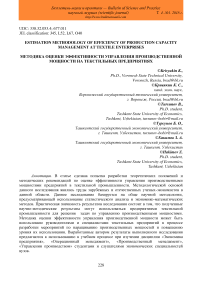Estimation methodology of efficiency of production capacity management at textile enterprises
Автор: Krivyakin Kirill, Tursunov Bobir, Hakimov Ziedulla
Журнал: Бюллетень науки и практики @bulletennauki
Рубрика: Экономические науки
Статья в выпуске: 1 т.4, 2018 года.
Бесплатный доступ
In this article have been made an attempt to develop theoretical provisions and methodological recommendations for evaluating the efficiency of managing the production capacity of enterprises in the textile industry. Methodological basis of this research was works of foreign and domestic scientists-economists in this field. This research has been based on a general scientific methodology that involves the use of statistical analysis and economic-mathematical methods. The practical significance of the research results is that the obtained scientific and methodological results can be used by textile industry enterprises to solve the tasks of managing production capacities. The methodology for assessing the effectiveness of management of production capacity can be used by managers and specialists of textile enterprises in the process of developing measures to increase production capacity and increase the level of their use. The developed by the author results of the research are proposed for use in the educational process when studying the disciplines “Enterprise Economics”, “Operational Management”, “Production Management”, “Production Management” by students and students of economic specialties of universities.
Management of production capacity, methodology, efficiency, production capacity, fixed assets, estimates, use of production capacity
Короткий адрес: https://sciup.org/14111774
IDR: 14111774 | УДК: 338.32.053.4; | DOI: 10.5281/zenodo.1147072
Список литературы Estimation methodology of efficiency of production capacity management at textile enterprises
- Новосадов С. Повышение конкурентоспособности предприятий текстильной промышленности//Маркетинг. 2007. №4. С. 102-110.
- Таласов М. Ж., Тулеметова А. С. Пути достижения конкурентоспособности текстильных изделий//Сборник научных трудов российских университетов «Проблемы экономики, финансов и управления производством». 2008. №25. С. 235-238.
- Baskaran V., Nachiappan S., Rahman S. (2012). Indian textile suppliers’ sustainability evaluation using the grey approach//International Journal of Production Economics. 2012. V. 135. №2. P. 647-658. DOI: 10.1016/j. ijpe.2011.06.012.
- Hasanbeigi A., Hasanabadi A., Abdorrazaghi M. Comparison analysis of energy intensity for five major sub-sectors of the Textile Industry in Iran//Journal of Cleaner Production. 2012. V. 23. №1. P. 186-194 DOI: 10.1016/j.jclepro.2011.10.037
- Loo B. P. (2002). The Textile and Clothing Industries Under the Fifth Kondratieff Wave: Some Insights from the Case of Hong Kong//World Development. V. 30. №5. Р. 847-872 DOI: 10.1016/S0305-750X(02)00005-0
- Mazumdar D. Import-substituting industrialization and protection of the small-scale: The Indian experience in the textile industry//World Development. 1991. V. 19. №9. P. 1197-1213 DOI: 10.1016/0305-750X(91)90067-R
- McAdam R., McClelland J. Sources of new product ideas and creativity practices in the UK textile industry//Technovation, 2002. V. 22. №2. 113-121 DOI: 10.1016/S0166-4972(01)00002-5
- Sondergård B., Hansen O. E., Holm J. Ecological modernisation and institutional transformations in the Danish textile industry//Journal of Cleaner Production. 2004. V. 12. №4. 337-352 DOI: 10.1016/S0959-6526(03)00049-0
- Truett L. J., Truett D. B. Globalization challenges for the Mexican textile industry//International Review of Economics & Finance. 2010. V. 19. №4. 733-741 DOI: 10.1016/j.iref.2010.04.003
- Турсунов Б. О. Ўзбекистонда тўқимачилик корхоналари ишлаб чиқариш қувватларидан самарали фойдаланиш масалалари//Иқтисодиёт ва инновацион технологиялар. 2017. №5. Режим доступа: http://iqtisodiyot.uz/sites/default/files/maqolalar/Tursunov.pdf.
- Вайтаускас Ю., Гракульских А., Петрулите Р. Оценка экономической активности сельскохозяйственных предприятий с использованием математических методов и компьютеров, 1972. Вильнюс: ЛитНИИЕШ, 1972. 264 с.
- Давыдова Т. Ю. Управление интеллектуальным и производственным потенциалом хозяйствующих субъектов на основе моделей синергетики и гибридного интеллекта//Научные труды Sworld. 2009. Т. 13. №1. С. 52-54.
- Карсунцева О. В. Методологические подходы к оценке производственного потенциала//Вестник университета (Государственный университет управления). 2013. №5. С. 126-132.
- Карсунцева О. В. Управление производственным потенциалом машиностроительных предприятий: теоретический и методологический аспект//Экономика и предпринимательство. 2013. №10 (39). С. 335-339.
- Крастин О. П. Применение регрессионного анализа в исследованиях экономики сельского хозяйства. Рига: Зинатне, 1976. 252 с.
- Нотченко В. В. Позиция российских предприятий на внешнем и внутреннем рынках//Современные аспекты экономики. 2005. №26 (93). С. 217-219.
- Родионова Н. В., Эриашвили Н. Д., Цыпкин А. и др. Управление сотрудниками фирмы. М.: Единство-Дана, 2002. 496 с.
- Саати T. Л. Принятие решений. Метод анализа иерархий. М.: Радио и связь, 1989. 316 с.
- Саати T. Л. Принятие решений с зависимостями и обратной связью: аналитические сети. М.: LKI, 2008. 360 с.
- Кибанов А. Я. Управление персоналом. М.: Кнорус, 2015. 202 с.
- Шапиро С. А. Мотивация и стимулирование персонала. М.: GrossMedia, 2005. 224 с.
- Бехар Г. Корпоративная культура Старбукс. М.: Альпина Паблишер, 2015. 186 с.
- Дадалова М. В. Управление производственными мощностями в стекольной промышленности: дисс. … канд. экон. наук. Белгород, 2009. 175 с.
- Tursunov B. Features of the method of calculation of production capacities of the textile enterprises//Бюллетень науки и практики. 2017. 10 (23). С. 213-222 DOI: 10.5281/zenodo.1012385


